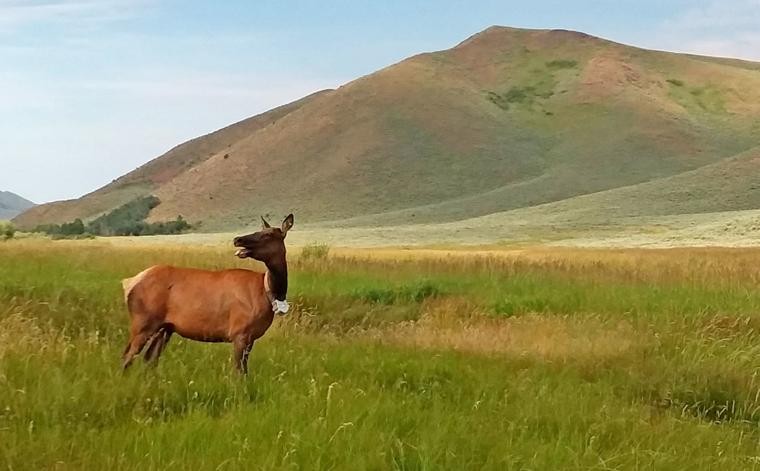It’s the week following the Fourth of July and a group of Idaho Department of Fish and Game employees have been busy collaring elk in western and central Idaho as part of a research study on deterrence measures to try to limit the increasing annual number of crop depredation claims Fish and Game is handling.
The collared elk are known as Judas elk. It’s a tactic used by Fish and Game to help track and monitor elk herd locations through the summer months leading up to the hunting season.
As the sun rises over the Soldier Mountains, John Guthrie, Fish and Game landowner and sportsman coordinator for the Magic Valley, is going over the details with his team at a farm on the Little Camas Prairie. They’re counting the number of collars and receivers they have on hand before beginning the process of finding, sedating and collaring elk.
This is the second year of Guthrie’s master’s project studying means to deter elk, deer and antelope from causing crop damage.
“Last year was kind of the first year we focused on elk that were living in that agricultural matrix, that interface between agriculture and wildlands,” Guthrie said in describing his research project.
“This place will have 300-plus elk on it in a month,” Guthrie said of the farm on the Little Camas Prairie. “What (elk) really like to do is hang out in those trees over there along Anderson Ranch Reservoir.”
The purpose in collaring elk in July is to ensure that they have elk that are part of the depredation problem for this farm.
With each passing day, July’s summer heat is becoming more oppressive. The winter wheat and barley are showing their heads a month from harvest. The potato plants have closed their rows and the plants are starting to flower.
The elk are moving into the fields and it’s time to begin tracking the elk and implementing lethal measures to deter them out of the grain, corn and potato fields.
Guthrie said that he and his staff take all the necessary precautions for animal safety and health. That’s why they restrict their time out to collar elk to the cool morning hours.
“A growing issue of elk in agriculture is why we’re doing it and trying to figure out, for this project, better tools that we can use to mitigate that (depredation) but also just a better understanding of depredating elk ecology,” Guthrie said in describing his research project and its role in helping reduce agricultural depredation.
On this day they are seeking elk in the Little Camas Prairie and east into the Magic Valley region. Yesterday was spent collaring elk in Weiser and Midvale. By the end of the week they will have collared 47 elk for Guthrie’s project.
During the past four years the Fish and Game has paid out more than $4 million from its Expendable Big Game Depredation Trust Account to Idaho farmers and ranchers for crop depredation. Last year one claim came in at over $1 million and Fish and Game paid over $2 million for 86 claims.
“We have seen increasing payments over the history of the program,” said Fish and Game director Ed Schriever about the EBGDTA.
“I think that’s a combination of sometimes it’s hard winters, sometimes it’s changes in distributions of big game, sometimes it’s related to commodity prices, sometimes it’s related to commodities being planted in places they haven’t been planted before,” Schriever said.
The collars come with radio transmitters that enable Fish and Game to keep track of the elk herds through the Judas elk’s GPS location. During the summer and fall the collars are transmitting the elks’ location every 20 minutes.
When the elk begin entering fields to graze and damage crops the Fish and Game will implement lethal measures to reinforce the deterrence lesson to the wildlife and try to minimize the depredation.
“We are an applied science agency and we spend a lot of time figuring out what is going on with animals,” Schriever said. “We have committed recently to bringing similar science-based resolution to this depredation issue.”
Along with the collared elk tactic, Guthrie is also studying the effectiveness of electrical fencing in keeping wildlife out of grain fields and using Plott Hounds to chase elk bedding in cornfields later in the summer.
He said that data from last year revealed that in one area elk were traveling six miles, as the crow flies, every night to feed in crop fields and that they obtained new information about migration routes and winter range for migrating elk herds.
“We also learned that when elk use agriculture fields in a more predictable manner, we were able to time our deterrence to impact the elk at a very scheduled time. There was very few treatments needed to deter those elk,” Guthrie said.



